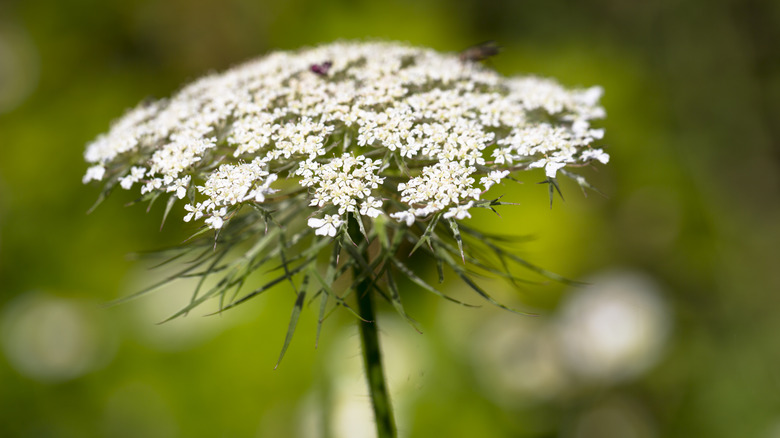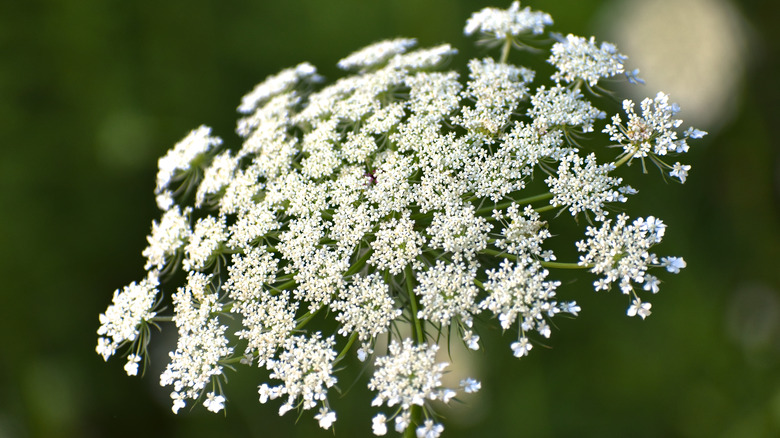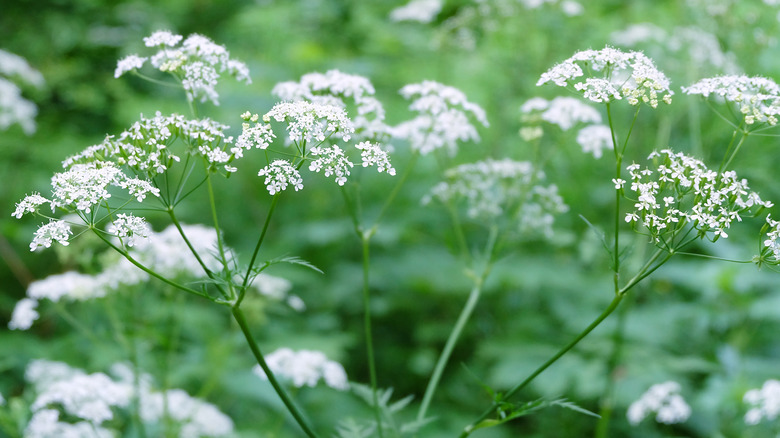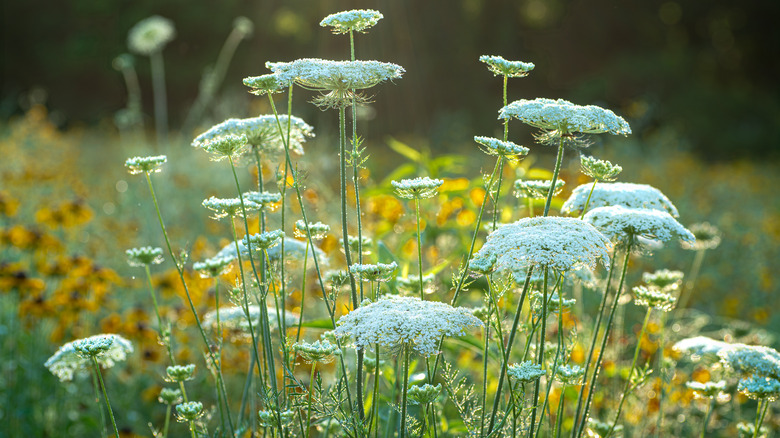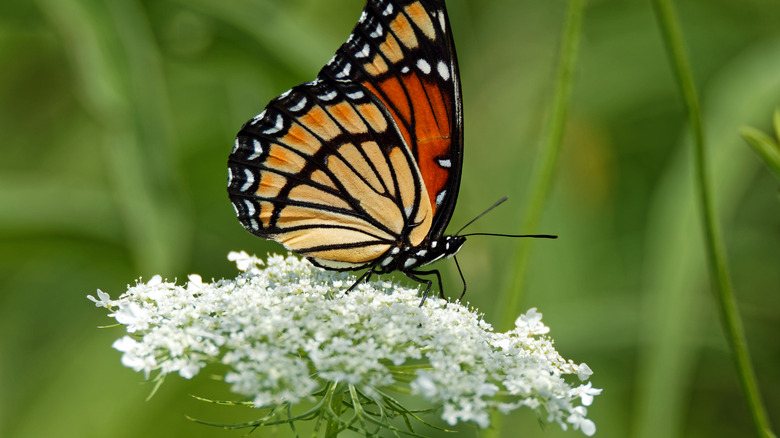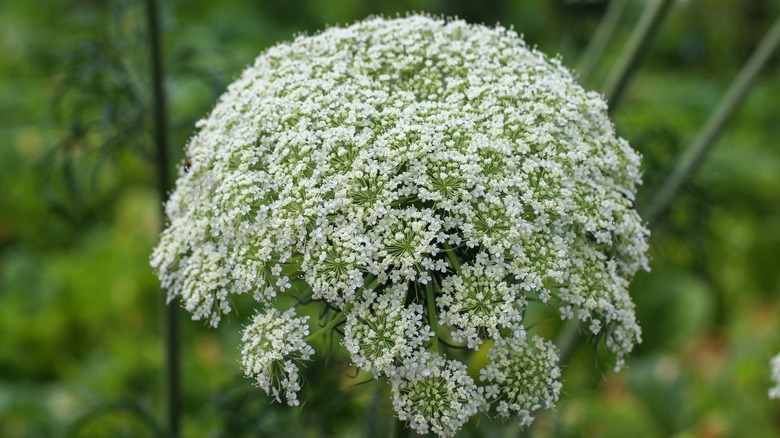How To Successfully Grow Queen Anne's Lace
Queen Anne's lace (daucus carota) is a species of wild carrot that grows naturally all over North America, and is even considered an invasive species in some parts of the continent. While some people think of the flowering plant as a nuisance and a weed, others seek them out for their gardens, appreciating their full foliage and delicate white flowers that grow in cloud like puffs.
According to Gardening Know How, the plant got its name from a legend that said Queen Anne, who ruled Great Britain from 1702 to 1714, pricked her finger while she was sewing, a drop of her blood landing on the piece of lace she was working with. The flower itself has dark purple buds, which are thought to resemble the fabled blood stained lace.
Queen Anne's lace is an incredibly easy to grow and maintain plant. It also has numerous benefits for the garden, as well as multiple options for use in landscaping. It's even edible, a fan favorite among foragers. Keep reading to learn how to care for and maintain this delicate and idyllic plant.
How to use Queen Anne's lace in garden
Queen Anne's lace are popularly grown in cottage gardens, their large, pillowy tufts of delicate white flowers creating an idyllic, romantic scene. They can be grown in conjunction with other flowers and plants to create a beautiful garden, meadow, or field. Per Flower Society, some of those companion plants include madia, a delicate yellow flower in the sunflower family, chicory, a small periwinkle blue flower in the daisy family, wild sweet pear or "harrow pear," which produces more ruffled white flowers, and thistles, which grow tall with a spiky base that supports a purple flower.
Many tend to avoid planting Queen Anne's lace and many of its companion plants as they are technically considered weeds. However, if not invasive, they have a multitude of benefits on top of their beauty. According to Common Sense Home, Queen Anne's lace attracts a wasp that kills drosophila flies, which attack blueberries, blackberries, and cherries. To that end, planting Queen Anne's lace among your fruit bushes and trees can help keep them safe from insects.
How to grow Queen Anne's lace
Queen Anne's lace is an incredibly easy to grow plant. Before deciding to plant it in your garden, though, take in a few considerations. According to MasterClass, the flowering wild carrot grows best in USDA hardiness zones 3 through 9. Queen Anne's lace is also considered an invasive species in many places. If your weather is too cold or the plant is considered invasive, consider growing it in a container that can be brought inside and the roots and seedlings can be maintained.
As noted by Gardening Channel, Queen Anne's lace grows very similarly to wildflowers. Choose a spot that gets plenty of sun, and has good, well-draining soil. Wait to seed until either the last frost of the season, or in the fall and wait for them to grow the following spring. Spread the seeds, and let them be. Keep the seedlings moist, but they don't need much tending to, if at all. They will produce lots of greenery and leaves in their first year, but not any flowers. The next year they will start to produce their signature, cloud shaped white flowers.
How to care for Queen Anne's lace
Caring for Queen Anne's lace is quite an easy task, making it a great option for cottage gardens. According to MasterClass, this flowering wild carrot only needs to be watered every now and then. Young plants like being moist, but fully matured Queen Anne's lace actually prefers to be dry. Natural rainfall should be enough to keep it going, and you should only water it yourself if there's a long drought period. The plant prefers full, bright sunlight, and will yield best results in these conditions. It can survive in light as low as partial shade, though.
Queen Anne's lace doesn't require fertilization, either, suggests Gardening Know How, as it already grows quickly on its own. With that in mind, there are things you should do to prevent the plant from reseeding and getting out of control. One way to do this is to regularly deadhead Queen Anne's lace; to do this, simply pinch a dying flower at the base and twist it off.
Is Queen Anne's lace toxic?
Many people are wary of Queen Anne's lace, as it bears a striking resemblance to the deadly poisonous plant, hemlock. Queen Anne's lace, though, is for the most part non-toxic to humans and animals, and is actually a favorite plant among foragers for its taste.
According to SFGate, Queen Anne's lace can be poisonous when the leaves are consumed in large amounts, and consumption should be monitored. However, the plant is generally not suitable for consumption for both humans and pets. The Forest Preserve District of Will County warns that some people may be allergic to the plant, which can cause skin irritation and blistering. Make sure to monitor yourself if you think you may be allergic to Queen Anne's lace, and to wear gloves when handling the plant if you're prone to sensitive skin.
For foragers with a trained eye that are able to discern between Queen Anne's lace and its deadly doppelganger, the plant can be made into a delicious snack or meal. Live Science recommends battering and frying the flower head, eating it raw, or using the seeds in soups, stews, and teas. Since it is a wild carrot, you can also treat it as such if you find one young enough. Be careful, though, because studies suggest the plant may cause issues in pregnant people and those trying to conceive, having been used as an ancient form of birth control.
How to repot Queen Anne's lace
Growing Queen Anne's lace in containers is a great idea for controlling the plant's growth in areas where it's considered invasive. If you live in a USDA zone that is either too cold or too hot to sustain the plant year round, it will also help you preserve it during extreme weather conditions.
According to Happy DIY Home, Queen Anne's lace is best grown in a deep container with drainage holes, as the plant can grow to be quite tall and full and needs depth to support its weight. They recommend using a water barrel that has been cut in half, but a large and deep ceramic, clay, terracotta, or plastic pot will do just fine.
SFGate recommends repotting in spring through fall during the plant's dormant season. Repotting should be done when you notice the plant is growing significant roots out of the bottom or top, or if it is showing signs of being root bound or having root rot. Other than that, a good rule of thumb is to uproot and refresh the soil every two to three years after all the nutrients have been absorbed. Use a well-draining, and perhaps loamy, potting soil.
